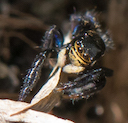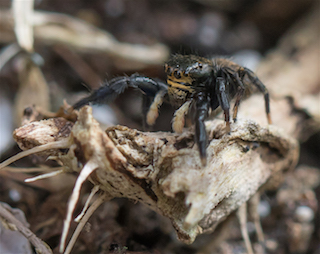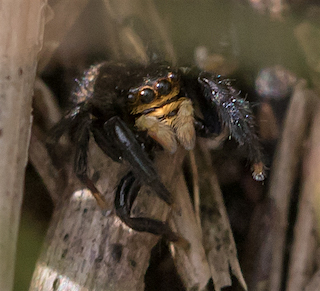 This attractive little species of Jumping Spider was spotted at Kennack Sands.
This attractive little species of Jumping Spider was spotted at Kennack Sands.
Photo: Tony Blunden
Scientific name: Euophrys herbigrada
Conservation status: Nationally notable (Na), found in between 16 and 30 ten-kilometre squares in Great Britain
What to look for:
• Family: Salticidae (Jumping Spiders)
• Colouring and appearance: Mainly dark brown to black. Females have a white ‘moustache’, and males have a yellow ‘moustache’ and creamy white palps.
• Size: Length, females ≤5 mm, males ≤4 mm.
• Where: A handful of south coast sites in Cornwall, Devon and Dorset.
• When: Adults have been recorded between April and June, and are active in the daytime.
 Euophrys herbigrada is a species of Jumping Spider known from only a few south coast sites, in Cornwall, Devon and Dorset, and The Lizard is a good place to find it. The individual recently spotted at Kennack Sands is probably the first record made there since before 1980.
Euophrys herbigrada is a species of Jumping Spider known from only a few south coast sites, in Cornwall, Devon and Dorset, and The Lizard is a good place to find it. The individual recently spotted at Kennack Sands is probably the first record made there since before 1980.
This is a species of short coastal grassland with areas of bare ground, as well as good cover to hide, found on dry south-facing slopes and cliff tops within a few hundred metres of the sea.
 Jumping spiders are busy, active and charismatic spiders that can be looked for on warm sunny days. Their behaviour, such as stalking prey and courtship, is fascinating to watch, involving intricate dances.
Jumping spiders are busy, active and charismatic spiders that can be looked for on warm sunny days. Their behaviour, such as stalking prey and courtship, is fascinating to watch, involving intricate dances.
Unlike many of the more cryptic species of nocturnal spiders, daytime-hunting Jumping Spiders have a strongly visual courtship, and have good colour vision. The structures and colouration of the spider (their facial pattern, palps and forelegs) play a more important part in species recognition than for nocturnal spiders.
Did you know…?
…There are more than 5000 described species of Jumping Spider globally, making it the largest spider family in the world (13% of all known spider species).
…Jumping Spiders have great vision, with four pairs of eyes: three pairs are fixed, but with wider angle vision than the principle pair, which however the spider can move to adjust its direction of view.
Published: May 2016
Author: Tony Blunden (‘Did you know…?’ added by Amanda Scott)
Photos: Tony Blunden
